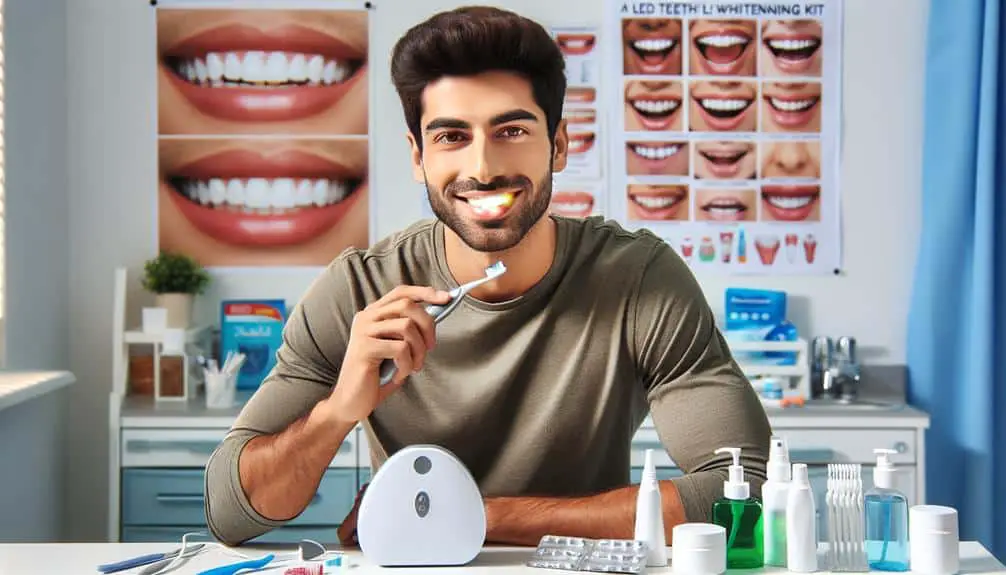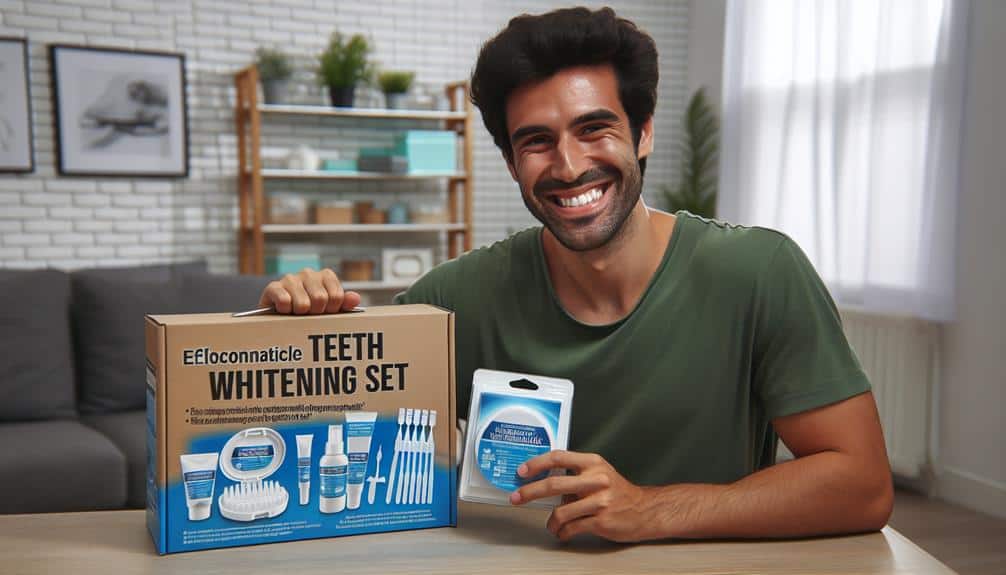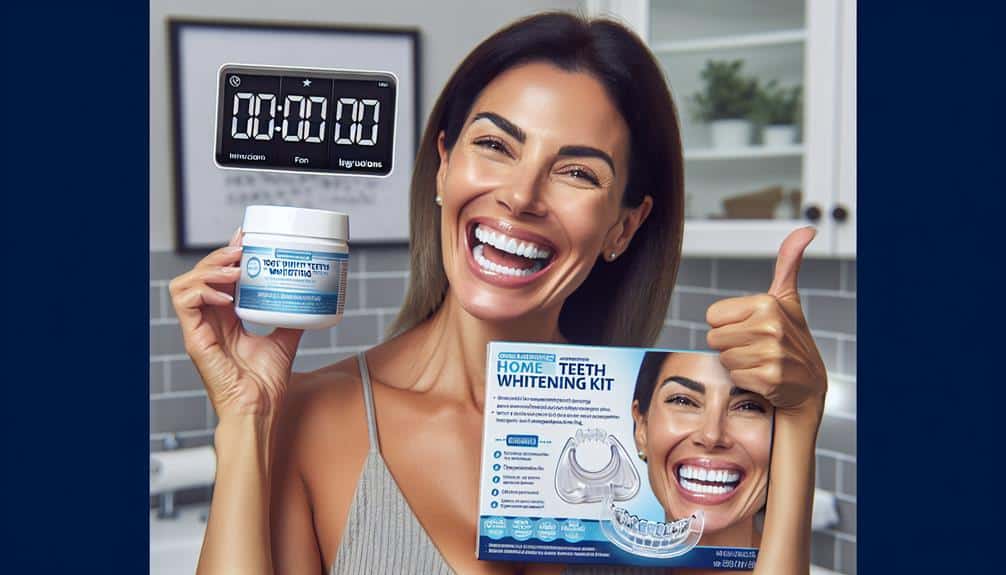To achieve peak results with your LED teeth whitening kit, start by preparing your teeth through thorough brushing and flossing. When applying the whitening gel, make sure to spread it evenly on each tooth surface in a thin, even layer. Maximize LED light exposure by following the recommended duration and maintaining the correct angle for even exposure. Manage sensitivity by shortening sessions if needed and using sensitive toothpaste for relief. After whitening, establish a post-care routine and monitor progress by tracking shade changes. Following these top 10 tips guarantees effective whitening and overall dental health.
Key Points
- Brush and floss teeth before whitening for best results.
- Follow LED kit instructions meticulously for safe usage.
- Use sensitive toothpaste if sensitivity occurs during whitening.
- Monitor progress by tracking shade changes before and after sessions.
- Store LED kit in a cool, dry place to maintain effectiveness.
Understanding LED Teeth Whitening Kits
When using LED teeth whitening kits, it's important to understand how the LED technology works to effectively brighten your smile. Choosing the right brand is essential for achieving best results. Look for reputable brands that offer quality LED teeth whitening kits with proven effectiveness. Understanding the benefits of LED technology is necessary.
LED lights emit a specific wavelength that activates the whitening agent in the gel, accelerating the whitening process. This technology can help whiten teeth more effectively and efficiently compared to traditional methods.
Selecting the right brand guarantees that you're using safe and reliable products. High-quality LED teeth whitening kits provide consistent results without causing harm to your teeth or gums. The LED technology in these kits targets stains on the surface of your teeth, breaking them down and revealing a brighter smile.
Preparing Your Teeth for Whitening
Prior to starting the whitening procedure, make sure you brush and floss your teeth thoroughly to eliminate any plaque or debris.
Look out for any indications of tooth sensitivity, such as pain or discomfort, as whitening treatments can occasionally worsen these problems.
Follow the guidelines provided with your LED teeth whitening kit attentively to achieve optimal results without causing harm to your teeth or gums.
Brush and Floss
To guarantee the best results from your LED teeth whitening kit, it's important to thoroughly brush and floss your teeth before proceeding with the whitening process. Proper technique in dental hygiene plays an essential role in preparing your teeth for whitening.
Start by brushing your teeth using a fluoride toothpaste and a soft-bristled toothbrush. Make sure you brush all surfaces of your teeth gently but effectively. Next, floss between each tooth to remove any food particles and plaque buildup.
Check for Sensitivity
Consider conducting a sensitivity check on your teeth before proceeding with the whitening process using an LED teeth whitening kit. Sensitivity management is vital to guarantee a comfortable experience and prevent any potential side effects.
Tooth sensitivity can be exacerbated by the whitening agents in the kit, so it's important to evaluate your teeth beforehand. To check for sensitivity, expose your teeth to the whitening gel for a short period as recommended in the kit instructions. If you experience any discomfort or pain, it may indicate underlying sensitivity issues.
In such cases, consult with your dentist for advice on how to proceed or for alternative whitening options that are gentler on sensitive teeth.
Follow Kit Instructions
Follow the instructions provided in the LED teeth whitening kit to properly prepare your teeth for the whitening process.
- Time management: Adhere to the recommended time frames for each step to maximize the effectiveness of the whitening treatment.
- Product effectiveness: Make sure you apply the whitening gel evenly on your teeth as instructed to achieve uniform whitening results.
- Consistency is key: Use the kit regularly following the guidelines to maintain the whiteness of your teeth and prevent discoloration.
Applying Whitening Gel Correctly
For optimal results, make sure the whitening gel is evenly spread on each tooth surface, avoiding excess application that may lead to irritation. Proper application of the gel is vital for effective teeth whitening.
Before applying the gel, ensure your teeth are clean and dry to maximize its adherence. Squeeze a small amount of gel onto the front surface of the tray for each tooth you intend to whiten. It's important to maintain the consistency of the gel application. Too much gel can seep out of the tray and irritate your gums.
On the other hand, too little gel may not cover all tooth surfaces adequately, resulting in uneven whitening. Aim for a thin, even layer of gel on the tray to achieve the best results. Remember, the key to successful whitening lies in the precision and consistency of the gel application process.
Maximizing LED Light Exposure
To maximize LED light exposure during teeth whitening, make sure you use the light for the recommended duration specified by the kit instructions.
Position the LED light at the correct angle to ensure all teeth receive even exposure.
This will help enhance the effectiveness of the whitening process and achieve best results.
Optimal Light Duration
Consider adjusting the duration of LED light exposure to maximize the effectiveness of your teeth whitening treatment. To guarantee excellent results, focus on the following:
- Light intensity adjustment: Set the LED light to the suggested intensity level for your kit.
- Proper timing accuracy: Follow the specified duration for each session precisely.
- Light distance calibration: Maintain the appropriate distance between the LED light and your teeth for effective light exposure.
Proper Light Angle
To optimize the exposure of LED light during your teeth whitening session, make sure the proper angle of the light to maximize its effectiveness.
Position the LED light at a 90-degree angle to your teeth for the best results. This angle guarantees maximum light intensity directly on the teeth, enhancing the whitening process.
Avoid positioning the light too close to your teeth, as this can cause discomfort or uneven whitening. Additionally, be mindful of reflective surfaces that may bounce the light away from your teeth, reducing its effectiveness.
Shadows can also interfere with the light reaching all areas of your teeth evenly. By paying attention to the angle and positioning of the LED light, you can achieve the best possible results in your teeth whitening journey.
Managing Sensitivity During Treatment
During your LED teeth whitening treatment, if you experience sensitivity, adjusting the duration of the sessions may help alleviate discomfort. Sensitivity management is essential for a comfortable whitening experience. Here are some tips to help you manage sensitivity during treatment:
- Shorter Sessions: Consider reducing the time of each whitening session. This can help minimize exposure to the whitening agents and lessen sensitivity.
- Use Sensitive Toothpaste: Brushing your teeth with sensitive toothpaste before and after treatment can help desensitize your teeth and provide relief.
- Avoid Extreme Temperatures: During the whitening process, try to avoid consuming very hot or cold foods and drinks. Extreme temperatures can exacerbate tooth sensitivity.
Maintaining Post-Whitening Care
For maintaining post-whitening care, it's important to establish a routine that includes essential oral hygiene practices to sustain the brightness of your teeth. After completing your LED teeth whitening treatment, focus on post-treatment maintenance to prolong the whitening results and manage any sensitivity that may arise.
Use a toothpaste specifically formulated for whitening to help maintain the shade of your teeth. Additionally, consider incorporating a fluoride mouthwash into your routine to strengthen enamel and reduce sensitivity.
Monitoring the whitening results is vital for tracking the shade of your teeth over time. Take regular photos in consistent lighting to accurately assess any changes. Keep in mind that some initial color rebound is normal, but maintaining good oral hygiene practices and avoiding staining foods and drinks can help sustain your bright smile.
If sensitivity persists, consult your dentist for personalized recommendations to address this concern effectively. By following these post-whitening care tips, you can enjoy a long-lasting, white smile.
Monitoring Whitening Progress
To effectively monitor your whitening progress, start by tracking shade changes before and after each session. Make sure to record your daily results to observe any improvements or changes in the color of your teeth over time.
This proactive approach will help you gauge the effectiveness of the LED teeth whitening kit and adjust your treatment as needed.
Tracking Shade Changes
Consider utilizing a shade guide to accurately track the changes in the color of your teeth while using LED teeth whitening kits. By monitoring the shade changes, you can effectively assess your progress and adjust your whitening routine if needed.
Here are three key tips for tracking shade changes:
- Shade Comparison: Regularly compare the current shade of your teeth to the shades on the guide to note any improvements.
- Daily Journaling: Maintain a daily journal noting the date, time, and any observations about the whitening process to track changes over time.
- Color Chart: Use a color chart provided with the LED teeth whitening kit to document and visually see the transformation in your teeth color.
Recording Daily Results
To effectively monitor the progress of your teeth whitening journey with LED kits, it's essential to record daily results of your whitening sessions. By consistently recording progress and tracking changes in the shade of your teeth, you can objectively evaluate the effectiveness of the LED teeth whitening kit you're using.
Create a simple chart or log where you note down the date, the duration of each session, any observations about sensitivity, and most importantly, the shade of your teeth before and after each session. This detailed record will allow you to identify any trends or improvements over time, helping you adjust your treatment plan if needed and ensuring you achieve the desired level of whitening efficiently.
Avoiding Common Mistakes
Make sure to carefully read and follow the instructions provided with your LED teeth whitening kit to avoid any common mistakes during the whitening process. Here are three key points to consider:
- Sensitivity Management: Prioritize sensitivity management by using desensitizing gel or toothpaste before and after the whitening treatment. This can help minimize any discomfort or sensitivity that may arise during or after the process.
- Proper Application: Ensure you apply the whitening gel evenly on each tooth's surface using the provided applicator or tray. Uneven application may result in inconsistent whitening effects across your teeth.
- Adhering to Timing: Follow the recommended timing guidelines specified in the instructions closely. Leaving the gel on for too long can lead to gum irritation, while removing it too soon may result in incomplete whitening.
Storing Your LED Kit Properly
Proper storage of your LED teeth whitening kit is crucial to maintain its effectiveness and prolong its shelf life. To guarantee the longevity of your kit, store it in a cool, dry place away from direct sunlight and moisture. Exposure to heat or humidity can impact the performance of the LED light and the quality of the whitening gel. Additionally, make sure to keep the components of the kit organized and protected. Store the LED light, mouth tray, and whitening gel in their designated compartments or packaging to prevent damage.
When storing the LED kit, avoid placing heavy objects on top of it, as this can cause the components to break or become misshapen. Proper storage not only preserves the functionality of the kit but also ensures that the whitening gel remains potent and effective. By following these guidelines for proper storage and LED kit maintenance, you can maximize the benefits of your teeth whitening treatment and achieve excellent results.
Consulting a Dentist for Guidance
Given the complexity of teeth whitening treatments and the unique characteristics of your dental health, seeking guidance from a dentist regarding your use of an LED teeth whitening kit is advisable. Dentists can provide valuable recommendations and benefits to make sure you achieve the best results while maintaining your oral health.
Here are some key points to take into account when consulting a dentist for guidance:
- Dentist Recommendations: Your dentist can suggest the most suitable LED teeth whitening kit based on your dental history, current oral health status, and whitening goals.
- Professional Advice: Dentists can offer expert advice on the correct usage of the LED kit, including the duration of each session, frequency of treatments, and potential side effects to watch out for.
- Precautions: Your dentist can emphasize any precautions you should take before, during, and after using the LED teeth whitening kit to minimize risks and maximize effectiveness.
Frequently Asked Questions
Can LED Teeth Whitening Kits Be Used on Dental Restorations Such as Crowns or Veneers?
Avoid using LED teeth whitening kits on dental restorations like crowns, veneers, bridges, or bonding. These materials do not respond to whitening treatments. Dental implants and porcelain veneers may need specialized care to maintain their appearance.
How Long Should I Wait to Eat or Drink After Using an LED Teeth Whitening Kit?
After using an LED teeth whitening kit, wait at least 30 minutes before consuming post-treatment snacks or drinks. Avoid dark-colored beverages like coffee or red wine immediately after. Opt for water or clear liquids to maintain whitening results.
Are LED Teeth Whitening Kits Safe to Use for Pregnant or Nursing Women?
Pregnant or nursing women should prioritize safety precautions when considering LED teeth whitening kits. Professional recommendations advise against their use due to potential risks. Consult with a dentist for alternative solutions during this time.
Can LED Teeth Whitening Kits Be Used on Children or Teenagers?
LED teeth whitening kits should not be used on children or teenagers without proper parental guidance. Age restrictions are in place due to developing dental structures. It's important to consult a dentist before considering such treatments for minors.
How Often Should I Use an LED Teeth Whitening Kit to Maintain Results?
For long term effectiveness, use an LED teeth whitening kit every 4-6 weeks. This ideal frequency helps maintain results without overdoing it. Consistency is key to achieving and preserving a brighter smile.



